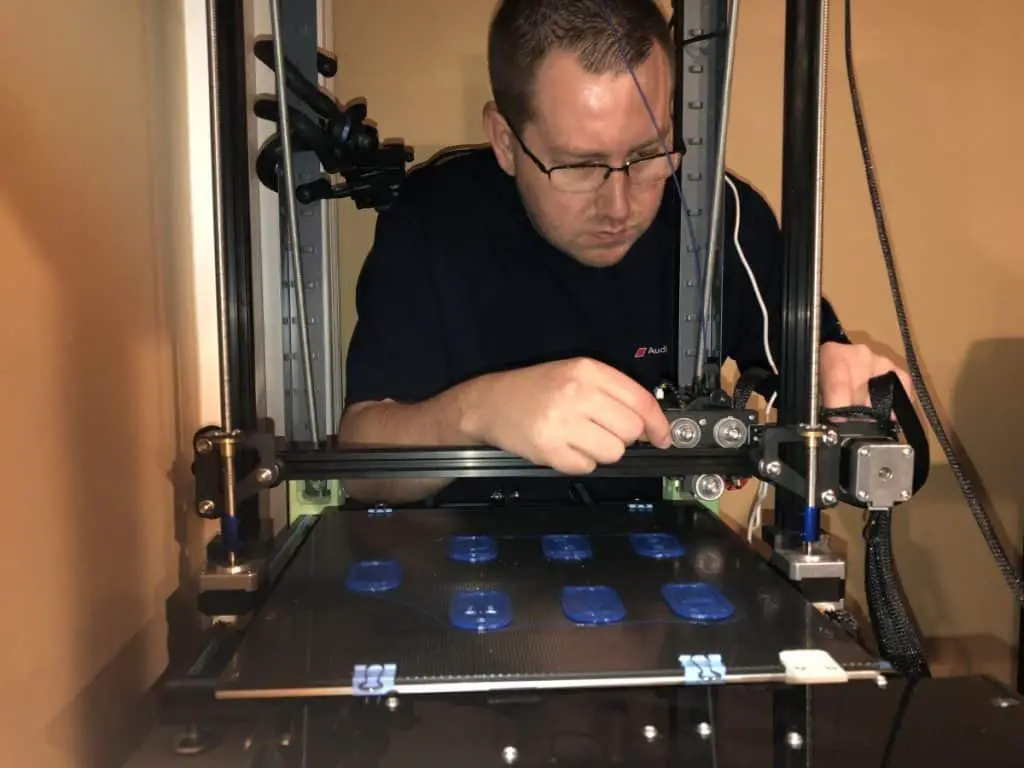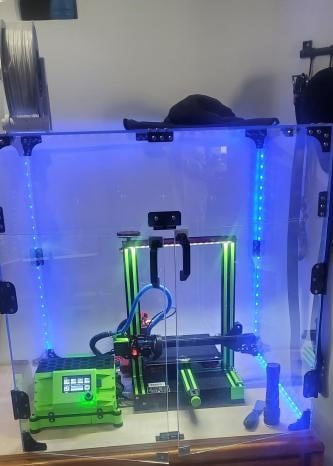A garage makes for an excellent 3D printing room because you can close it off from pets and children. You’re also less likely to hear it if you’re printing a job overnight. But there are a few things that you need to know before setting your 3D printer up in your garage.
3D printing in a garage is perfect if it’s well-insulated and has ventilation to extract heat and fumes from the melted plastic. Make sure the smoke detector works and use an enclosure. Install additional power outlets and lighting. Store filaments and chemicals in cool, dust-free cabinets.
Garage cabinets help keep all your materials cool and clean to prevent printing problems. Dust and moisture cause blockages and a popping sound in the extruder.
You don’t have to worry too much about toxic fumes if you’re printing with PLA. However, you still need to extract the air because some PLA filaments contain small amounts of chloromethyl methyl sulfide and 12-crown-4 which are harmful if you have no ventilation at all.
ABS, PETG, nylon, and a few other popular filaments release harmful fumes that you need to extract out of the garage rapidly.
Since you probably won’t want to sit around for every print to complete, you should also look at installing an Octoprint webcam to monitor the situation remotely.
Of course, all this information applies to any room used for 3D printing, but there are some specific things that you need to take care of in a garage to make it suitable for storing and running a 3D printer.

How To Prepare A Garage For 3D Printing
The main difference between a garage and a spare room in a house is the climate difference because garages might not be insulated as well as the rooms of a house. They also might not have air-conditioning ducts to circulate, recycle and cool the air. If you have a detached garage, you’ll need to make many improvements.
Insulate the garage
You need to insulate the garage to avoid low temperatures that will cause the printer to underperform. Insulation also helps to keep the temperature down in the summer so that parts don’t overheat.
The most common type of insulation is fiberglass. It’s inexpensive and easy to install. But only install it if you have the proper protection because fiberglass will cause skin, eye, and lung irritation if you come into contact with it.
Rigid foam and spray foam are also great options, although I recommend professionals apply the latter. Rigid is the more affordable DIY foam.
Insulate the door, walls, and ceiling of the garage for maximum effect.
Install a smoke detector and fire-extinguisher
A garage should already have this safety equipment, but using a 3D printer makes them even more important. Make sure the smoke detector batteries are working and that the fire extinguisher is serviced regularly.
Install power outlets
If your garage doesn’t have its own power outlets built in, don’t run a long extension to the garage to power everything. Ideally, you should plug the printer into its own outlet without anything else. Connecting too many electronics to one extension can cause a fire or performance loss in the equipment.
You might also need extra power points close to a desk for a 3D pen for mending parts or a heat gun for post-processing.
Add additional lighting
A 3D printing environment needs to be very well-lit for you to see what’s going on. Especially for cleaning and maintaining the printer. From cleaning out a nozzle to tensioning belts, it’s best you have plenty of lighting.
It needs to be bright enough for you to see the finest details on the prints. It also helps to see what’s happening on the cameras.

Use A 3D Printer Enclosure
An enclosure has many benefits even if you’re only working with PLA.
- It makes it safer to print. You can leave the print going and come back to it later knowing that it hasn’t been touched by pets or children.
- An enclosure helps to regulate the temperature around the part to minimize defects.
- If it’s too hot or too cold in the garage, an enclosure with an extraction duct will allow the printer to heat up faster in the winter or keep cool in the summer.
- If you’re in the room next to the garage, you might hear the printer working, but an enclosure will eliminate the sound completely.
- You should make use of an extraction system to suck the hot air out of the enclosure and blow it out of the window.

Use OctoPrint
Octoprint is a web interface that allows you to control many aspects of your printer remotely. This is especially convenient when a 3D printer’s in your garage. OctoPrint displays different statuses and parameters for you to keep tabs on and make sure everything is running smoothly. Check this video out for more OctoPrint information.
Block off sunlight from windows
Block any sunlight from coming through windows to avoid print defects from overheating the plastic. Sunlight will also increase the ambient temperature of the garage, so blocking them off with privacy film will keep things cool. It’s also a good way to keep eyes off the garage contents.
Another cheap and easy solution is privacy spray foam, also called “Frosted Glass”. Just spray it on the windows to eliminate any direct sunlight.
Add security measures
The garage is more likely to be broken into than a room in your house. So it’s a good idea to install a camera and some security sensors like motion detectors. Just make sure not to get the movement of the printer in the way of the sensors.
Use cabinets for storage
With a garage being susceptible to temperature fluctuations, you can’t keep your materials like the filament in the open. Unless you constantly air condition the garage along with the house. I suggest you use garage cabinets to keep all your materials cool and dry.
It can also get humid in a garage which will add moisture to the filament and cause problems while printing. If you think the filament has some moisture in it, you can dry it a bit with a hairdryer. Just be careful not to deform it with too much heat.
Ideal Garage Temperature For 3D Printing
The ideal ambient temperature range for most filaments is 15°C (59°F) to 30°C (86°F). The easiest way to achieve this is to insulate the garage well. From there, an air conditioner can keep the temperature regulated.
Use an enclosure to better regulate the temperature and keep the garage cooler with the help of an extraction duct.
Related Articles
- How Much Ventilation Does a 3D Printer Need?
- 3D Printer Enclosure – Do I Actually Need One?
- Create a Temperature Tower Using Cura – The Easy Way
- Cura Profiles
- 3D Printer Filament Storage Options
- All About 3D Printer Plastic
In Summary
3D printing in a garage is entirely possible if you prepare the garage accordingly. Make sure the temperature is between 15°C and 30°C. Going below this range will shouldn’t be detrimental but will cause the printer to take longer to warm up. Going over 30°C increases the possibility of thermal shutdowns that can cause print failures.
So insulate your garage and make sure there’s enough ventilation and air conditioning. Install bright lighting and a camera to monitor the area remotely. Put film over windows to block harsh sunlight and extra privacy.
OctoPrint is extremely useful for controlling and monitoring your printer remotely. Store filaments in cabinets to protect them from dust and moisture and don’t forget to service the smoke detector and fire extinguisher regularly.
Make sure you check out our YouTube channel, and if you would like any additional details or have any questions, please leave a comment below or join us on Discord. If you liked this article and want to read others click here.
